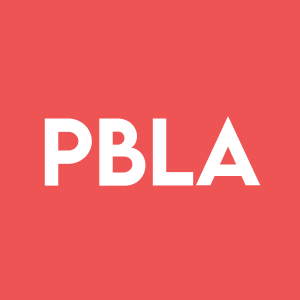Panbela Announces Partial Clinical Hold Lifted on Phase I Polyamine Metabolic Inhibitor Study in Pancreatic Cancer
Panbela Therapeutics (Nasdaq: PBLA) announced that the FDA has lifted the partial clinical hold on its Phase 1 study for SBP-101. This therapeutic candidate aims to treat metastatic pancreatic ductal adenocarcinoma in combination with gemcitabine and nab-paclitaxel. The study will now exclude patients with a history of retinopathy and include ophthalmologic monitoring. SBP-101 has shown promise in inhibiting tumor growth without exacerbating common chemotherapy-related adverse effects. The FDA's decision allows for continued evaluation of SBP-101 in clinical trials.
- None.
- None.
Insights
Analyzing...
MINNEAPOLIS, April 15, 2021 (GLOBE NEWSWIRE) -- Panbela Therapeutics, Inc. (Nasdaq: PBLA), a clinical stage biopharmaceutical company developing disruptive therapeutics for the treatment of patients with cancer today announced the U.S. Food and Drug Administration (FDA) has lifted the partial clinical hold on the company's Phase 1 first-line study of SBP-101 when used in combination with standard of care agents gemcitabine and nab-paclitaxel for treatment of patients with metastatic pancreatic ductal adenocarcinoma (PDA). SBP-101 is the company's first polyamine metabolic inhibitor therapeutic candidate.
The company has agreed to include in the design of all future studies the exclusion of patients with a history of retinopathy or at risk of retinal detachment and scheduled ophthalmologic monitoring for all patients. Additionally, in future dose-finding studies screening for retinal toxicity will be included.
About SBP-101
SBP-101 is a proprietary polyamine analogue designed to induce polyamine metabolic inhibition (PMI) by exploiting an observed high affinity of the compound for pancreatic ductal adenocarcinoma and other tumors. The molecule has shown signals of tumor growth inhibition in clinical studies of US and Australian metastatic pancreatic cancer patients, suggesting potential complementary activity with an existing FDA-approved standard chemotherapy regimen. In data evaluated from clinical studies to date, SBP-101 has not shown exacerbation of bone marrow suppression or peripheral neuropathy, which can be chemotherapy-related adverse events. Recently observed serious visual adverse events are being evaluated and patients with a history of retinopathy or at risk of retinal detachment are excluded from SBP-101 studies. The safety data and PMI profile observed in the current Panbela sponsored clinical trial provides support for continued evaluation of SBP-101 in a randomized clinical trial. For more information, please visit https://clinicaltrials.gov/ct2/show/NCT03412799 .
About Panbela
Panbela Therapeutics, Inc. is a clinical-stage biopharmaceutical company developing disruptive therapeutics for patients with urgent unmet medical needs. The company’s initial product candidate, SBP-101, is for the treatment of patients with metastatic pancreatic ductal adenocarcinoma, the most common type of pancreatic cancer. Panbela Therapeutics, Inc. is dedicated to treating patients with pancreatic cancer and exploring SBP-101’s potential for efficacy in combination with other agents in other cancer indications. Further information can be found at www.panbela.com . Panbela Therapeutics, Inc. common stock is listed on The Nasdaq Stock Market LLC under the symbol PBLA.
Cautionary Statement Regarding Forward-Looking Statements
This press release contains “forward-looking statements,” including within the meaning of the Private Securities Litigation Reform Act of 1995. Forward-looking statements can be identified by words such as: “believes,” “expect,” “intend,” “may,” “plan,” and “will.” Examples of forward-looking statements include statements we make regarding the design and conduct of future clinical trials. Forward-looking statements are neither historical facts nor assurances of future performance. Instead, they are based only on our current beliefs, expectations, and assumptions regarding the future of our business, future plans and strategies, projections, anticipated events and trends, the economy and other future conditions. Because forward-looking statements relate to the future, they are subject to inherent uncertainties, risks and changes in circumstances that are difficult to predict and many of which are outside of our control. Our actual results and financial condition may differ materially and adversely from the forward-looking statements. Therefore, you should not rely on any of these forward-looking statements. Important factors that could cause our actual results and financial condition to differ materially from those indicated in the forward-looking statements include, among others, the following: (i) our ability to obtain additional funding to complete a randomized clinical trial; (ii) progress and success of our Phase 1 clinical trial; (iii) the impact of the current COVID-19 pandemic on our ability to complete monitoring and reporting in our current clinical trial; (iv) our ability to demonstrate the safety and effectiveness of our SBP-101 product candidate (v) our ability to obtain regulatory approvals for our SBP-101 product candidate in the United States, the European Union or other international markets; (vi) the market acceptance and level of future sales of our SBP-101 product candidate; (vii) the cost and delays in product development that may result from changes in regulatory oversight applicable to our SBP-101 product candidate; (viii) the rate of progress in establishing reimbursement arrangements with third-party payors; (ix) the effect of competing technological and market developments; (x) the costs involved in filing and prosecuting patent applications and enforcing or defending patent claims; and (xi) such other factors as discussed in Part I, Item 1A under the caption “Risk Factors” in our most recent Annual Report on Form 10-K, any additional risks presented in our Quarterly Reports on Form 10-Q and our Current Reports on Form 8-K. Any forward-looking statement made by us in this press release is based on information currently available to us and speaks only as of the date on which it is made. We undertake no obligation to publicly update any forward-looking statement or reasons why actual results would differ from those anticipated in any such forward-looking statement, whether written or oral, whether as a result of new information, future developments or otherwise.
Contact Information:
Investors:
James Carbonara
Hayden IR
(646) 755-7412
james@haydenir.com
Media:
Tammy Groene
Panbela Therapeutics, Inc.
(952) 479-1196
IR@panbela.com






